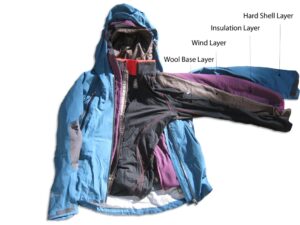Staying Warm in Cold Weather: Layering and Material Basics for Hypothermic Prevention
Cold weather presents an extreme challenge for outdoor adventurers and can quickly put them in danger of hypothermia. Knowledge and careful selection of layers and materials are essential to protect against hypothermia and maintain optimal comfort levels, no matter the conditions.

Layering Basics
In almost all situations, a three-layer system of clothing should be all that is necessary in order to protect against the cold weather. This comprises a base layer, a mid-layer, and a shell. A fourth layer may needed in harsher conditions, especially in extreme cold. However, the temperature should be maintained with the correct selection of materials and layering.
The base layer should ideally be a long-sleeve layer made from merino wool or aero-fabric, which performs well in both hot and cold climates. This layer is the most versatile and should be comfortable even in the warmest conditions.
The more specialized mid-layer provides the primary insulation and is designed to give the body warmth in situations such as tree stands, sitting in chilly weather, glassing on an exposed ridge, and around camp at night. Popular options for this mid-layer include a puffy down jacket due to its lightweight nature and breathability.
Finally, your shell acts as your waterproof/windproof layer while helping bridge the gap between hot and cold temperatures. It is essential this layer fits conveniently over the mid-layer, as a mistake in this may mean struggling in temperature conditions far colder than anticipated.

Choosing The Right Materials
Getting the correct materials is highly important to avoid issues such as discomfort, ill-fitting garments, breathability issues, and potentially severe problems like hypothermia.
For the base layer, merino wool and polyester blends are popular materials, combining insignificant levels of weight while maintaining breathability. Cotton is also available, but it tends to absorb and accumulate moisture, so it is not advised in any situation.
The primary choice for a mid-layer is down or synthetic insulation. Down is lighter, compacts better, and is more breathable, but synthetic is much more affordable and withstands rain and moisture better.
Finally, the shell is typically made from Gore-Tex fabric, which allows the garment to be adapted according to its waterproofness and breathability. As waterproof fabric becomes more advanced, it is possible to find highly breathable and waterproof innerwear.
In Conclusion
Safety is paramount when in cold conditions, and this can be maintained with the correct choice of layering and materials. Remember these guidelines next time you head out into the cold, and ensure you remain ready to tackle whatever nature can throw your way.


